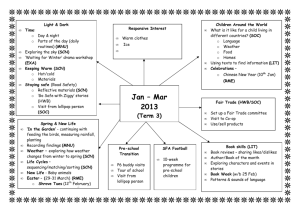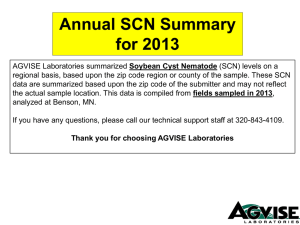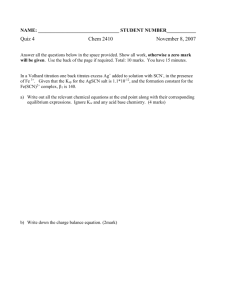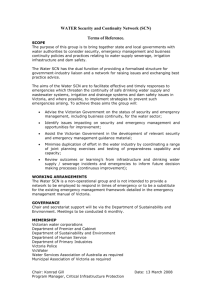Wallace's Farmer, IA 11-07-07 Chose High-Yielding, SCN-resistant Soybeans
advertisement
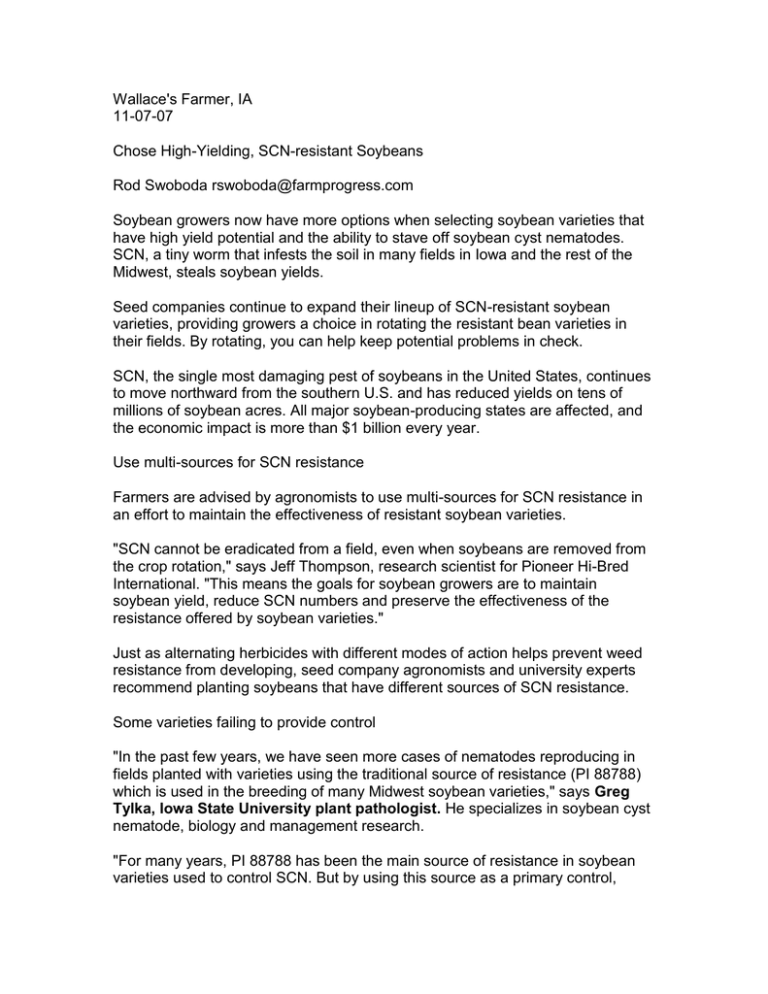
Wallace's Farmer, IA 11-07-07 Chose High-Yielding, SCN-resistant Soybeans Rod Swoboda rswoboda@farmprogress.com Soybean growers now have more options when selecting soybean varieties that have high yield potential and the ability to stave off soybean cyst nematodes. SCN, a tiny worm that infests the soil in many fields in Iowa and the rest of the Midwest, steals soybean yields. Seed companies continue to expand their lineup of SCN-resistant soybean varieties, providing growers a choice in rotating the resistant bean varieties in their fields. By rotating, you can help keep potential problems in check. SCN, the single most damaging pest of soybeans in the United States, continues to move northward from the southern U.S. and has reduced yields on tens of millions of soybean acres. All major soybean-producing states are affected, and the economic impact is more than $1 billion every year. Use multi-sources for SCN resistance Farmers are advised by agronomists to use multi-sources for SCN resistance in an effort to maintain the effectiveness of resistant soybean varieties. "SCN cannot be eradicated from a field, even when soybeans are removed from the crop rotation," says Jeff Thompson, research scientist for Pioneer Hi-Bred International. "This means the goals for soybean growers are to maintain soybean yield, reduce SCN numbers and preserve the effectiveness of the resistance offered by soybean varieties." Just as alternating herbicides with different modes of action helps prevent weed resistance from developing, seed company agronomists and university experts recommend planting soybeans that have different sources of SCN resistance. Some varieties failing to provide control "In the past few years, we have seen more cases of nematodes reproducing in fields planted with varieties using the traditional source of resistance (PI 88788) which is used in the breeding of many Midwest soybean varieties," says Greg Tylka, Iowa State University plant pathologist. He specializes in soybean cyst nematode, biology and management research. "For many years, PI 88788 has been the main source of resistance in soybean varieties used to control SCN. But by using this source as a primary control, there have been cases where nematode control has not been as effective," says Tylka. "While these reports have been isolated, they are increasing in number. Reports of PI 88788 resistance being overcome by the cyst nematode and signs that this pest continues to spread north have certainly encouraged the development and expansion of SCN-resistant varieties." The Peking source of SCN resistance can be used in soybean varieties but it has not been widely deployed by soybean breeders in the Midwest. However, Pioneer researchers, using sophisticated molecular marker technology, have integrated Peking SCN resistance into a number of high-performance soybean varieties. Marker-assisted selection allows the breeders to track the genes associated with resistance and increases their effectiveness in combining yield improvement with SCN genes. Selecting for resistance markers makes the breeding process both faster and more efficient. "In addition to the source of resistance, the genetic background also plays a role in a variety's ability to control SCN," says Thompson. "Rotating resistant varieties is often a good strategy for controlling an SCN population." Determining SCN levels in the field "Farmers can experience SCN damage and not realize it - making SCN an extremely difficult challenge to manage," says Tylka. "There can be as much as 30% to 40% potential yield loss due to SCN damage below ground, but the plant actually can look healthy above ground. Therefore, growers may attribute yield loss at harvest time to other factors during the growing season." Tylka encourages farmers to consider either sampling their soil or examining root systems of soybeans in their fields to determine if SCN is present. There are several factors to keep in mind for both management tools. Soil sampling is more costly, but can be done nearly anytime of the year, and once a baseline is determined, soil sampling can be spread out to every six to eight years. Examining root systems is virtually a no-cost option, but can be done only at certain times during the growing season - July or August. SCN makes other diseases worse, too "Farmers need to know that besides waging a costly battle on its own, SCN also can intensify other yield-reducing diseases for soybeans," says Tylka. "Research shows SCN can worsen soilborne, fungal diseases such as sudden death syndrome and brown stem rot. Keeping SCN numbers under control also can benefit growers by limiting the impact of other diseases." While research has focused mainly on yield loss caused by SCN, now the focus is starting to shift to determine the potential quality damage. According to Tylka, Iowa State University, with soybean check-off funding, is exploring if SCN has an impact on soybean composition, such as oil or protein content. With the everincreasing production of specialty crops, including low-linolenic and high-oleic soybeans, retaining desired composition is a key end result. New SCN resistance varieties for 2008 "Maintaining adequate soil fertility, reducing compaction, and controlling weeds, diseases and insects all improve soybean growth and plant health," says Thompson. "These practices help soybean plants compensate for SCN damage, however, they do not decrease SCN numbers and are not a substitute for practices such as rotating crops and selecting the right SCN-resistant varieties." To help growers address the challenge of SCN, Pioneer is expanding its lineup of soybean varieties with multi-sources of SCN resistance to include products across a wide geographic area in 2008 - including northern and central areas of the Corn Belt, says Thompson.
